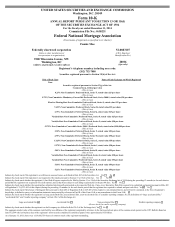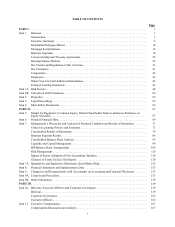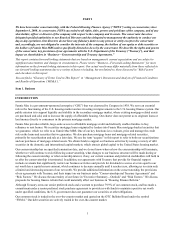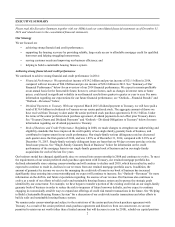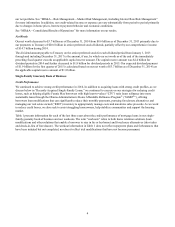Fannie Mae 2014 Annual Report Download - page 8
Download and view the complete annual report
Please find page 8 of the 2014 Fannie Mae annual report below. You can navigate through the pages in the report by either clicking on the pages listed below, or by using the keyword search tool below to find specific information within the annual report.3
or pay dividends or other distributions to stockholders other than Treasury. See “Conservatorship and Treasury Agreements”
for more information regarding our conservatorship and our senior preferred stock purchase agreement with Treasury. In
addition, the future of our company remains uncertain. Congress continues to consider options for reform of the housing
finance system, including the GSEs, and we cannot predict the prospects for the enactment, timing or final content of housing
finance reform legislation. See “Housing Finance Reform” for information on recent proposals for housing finance reform.
Supporting the housing recovery by providing reliable, large-scale access to affordable mortgage credit for qualified
borrowers and helping struggling homeowners
We continued our efforts to support the housing recovery in 2014. We remained the largest single issuer of mortgage-related
securities in the single-family secondary market in 2014 and a continuous source of liquidity in the multifamily market. We
also continued to help struggling homeowners. In 2014, we provided approximately 165,000 loan workouts to help
homeowners stay in their homes or otherwise avoid foreclosure. We discuss our activities to support the housing and
mortgage markets in “Contributions to the Housing and Mortgage Markets” below.
Serving customer needs and improving our business efficiency
We are undertaking various initiatives to better serve our customers’ needs and improve our business efficiency, including:
revising and clarifying our representation and warranty framework to reduce lenders’ repurchase risk; simplifying our
business processes; and updating our infrastructure. We discuss these initiatives in “Serving Customer Needs and Improving
Our Business Efficiency” below.
Helping to build a sustainable housing finance system
We continued to help lay the foundation for a safer and sustainable housing finance system in 2014. Our efforts included
pursuing the strategic goals and objectives identified by our conservator, as well as investing in enhancements to our business
and infrastructure. We discuss these efforts in “Helping to Build a Sustainable Housing Finance System” below.
Summary of Our Financial Performance
Comprehensive Income
We recognized comprehensive income of $14.7 billion in 2014, consisting of net income of $14.2 billion and other
comprehensive income of $530 million. In comparison, we recognized comprehensive income of $84.8 billion in 2013,
consisting of net income of $84.0 billion and other comprehensive income of $819 million. The decrease in comprehensive
income was primarily driven by a provision for federal income taxes of $6.9 billion in 2014 compared to a benefit for federal
income taxes of $45.4 billion in 2013 primarily due to the release of our valuation allowance against our deferred tax assets
in the first quarter of 2013. See “MD&A—Critical Accounting Polices and Estimates—Deferred Tax Assets” for additional
information.
Our 2014 pre-tax income was $21.1 billion, compared with $38.6 billion in 2013. The decrease in our pre-tax income was
primarily due to a decrease in credit-related income and a shift to fair value losses from fair value gains.
Credit-related income decreased to $3.8 billion in 2014 from $11.8 billion in 2013. This decrease was primarily attributable
to home prices increasing at a slower pace in 2014 as compared with 2013. In addition, 2013 credit-related income benefited
from foreclosed property income primarily due to the recognition of income related to compensatory fee arrangements.
Fair value losses of $4.8 billion in 2014 were primarily driven by a decline in longer-term swap rates in 2014. Fair value
gains of $3.0 billion in 2013 were primarily driven by an increase in longer-term swap rates in 2013.
Our results included pre-tax income of $5.7 billion in each of 2014 and 2013 as a result of resolution agreements we reached
relating to private-label mortgage-related securities (“PLS”) sold to us, representation and warranty matters, and
compensatory fees.
We expect volatility from period to period in our financial results from a number of factors, particularly changes in market
conditions that result in fluctuations in the estimated fair value of the financial instruments that we mark to market through
our earnings. These instruments include derivatives and certain securities. The estimated fair value of our derivatives and
securities may fluctuate substantially from period to period because of changes in interest rates, the yield curve, mortgage
spreads and implied volatility, as well as activity related to these financial instruments. We use derivatives to manage the
interest rate risk exposure of our net portfolio, which consists of our retained mortgage portfolio, cash and other investments
portfolio, and our outstanding debt of Fannie Mae. Some of these financial instruments in our net portfolio are not recorded at
fair value in our consolidated financial statements, and as a result we may experience accounting gains or losses due to
changes in interest rates or other market conditions that may not be indicative of the economic interest rate risk exposure of

